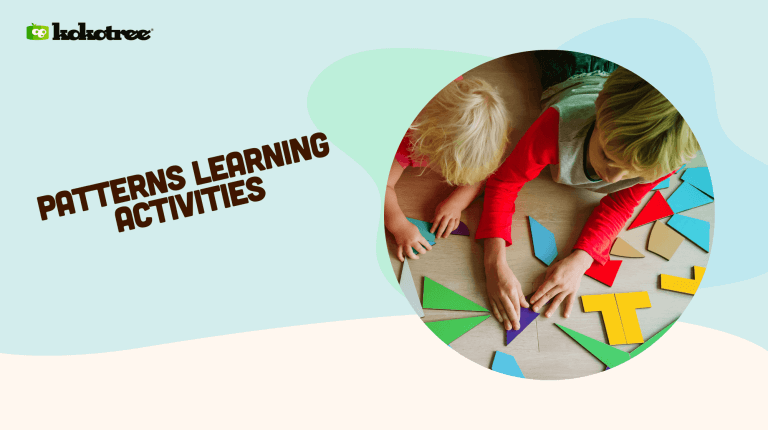

Teaching patterning skills to preschoolers is a critical step in their journey toward understanding more advanced math concepts. It’s not just about recognizing and duplicating patterns but also about creating their own. Preschool math can be a fun and engaging, especially when it involves patterns.
Starting with simple AB patterns and gradually moving on to more complex ABC patterns can make learning smoother for your little ones. It’s essential to model the patterning activity first and then let your preschooler complete the pattern on their own. Remember, understanding patterns and sequences, even in abstract ways, lays the groundwork for their future math prowess.
For ages 2-6. They watch and play for 20 minutes. You get a break.
⭐ 5,000+ parents get daily breaks with Kokotree.
Try it Free →Works in 30 seconds • No credit card • Cancel anytime
Incorporating pattern activities into your little one’s day is more accessible. There are many fun ways to teach positions and patterns, and you’re likely already implementing many of these.
When initially teaching patterns, it’s best to start with something simple. Consistency is critical here, so I suggest working on AB patterns before exploring the more challenging ABC patterns. It’s also helpful to model the activity beforehand, walking your preschooler through the process before they attempt to complete the pattern on their own.
Interestingly, I’ve noted changes in the pattern recognition abilities of many preschoolers over time. Earlier, they might need to notice or hear a pattern. I recommend a sing-song reading of the pattern to aid them better, pointing to each item as you go. Adding positional and ordinal words into your descriptor arsenal will also enhance learning.
Remember, preschoolers thrive on repetition. Have them read the pattern they’re to continue before actually doing so. Also, encourage your preschooler to copy the pattern. It’s not about a deluge of information – instead, keeping it light, engaging, and repetitive.
Along their patterning journey, children will naturally pass through several stages. They’ll start with identifying a pattern or its anomalies, gradually progressing to reading, coping, and continuing a pattern. This will then lead to creating new patterns, eventually recognizing number patterns. As a parent or teacher, it’s essential to understand this progression and apply it to your teaching methods accordingly.
In some cases, regardless of pattern activities, children might still find creating their patterns a challenge. But don’t worry: there are numerous tips for helping children develop their pattern skills, which we’ll detail further in this discussion.
As an experienced early educator, I can’t stress enough the importance of pattern activities for preschoolers. They form an essential foundation for more advanced mathematical concepts. Pattern recognition, for instance, isn’t just about spotting similarities. It’s a vital step in understanding sequences and creating one’s own.
Teaching preschoolers about patterns is more than a simple academic exercise. It’s about equipping them with a skill to serve them throughout their lives. In abstract ways, it helps young learners understand the world. I’ve seen firsthand the confidence a child gains when they crack a pattern for the first time. It’s one small step towards independent problem-solving.
A firm favorite among my preschoolers is manipulative activities. They are tactile, colorful, and engaging. By handling physical objects, children learn to recognize and replicate patterns. They also begin to create their own. And let me tell you, there’s no greater joy than seeing their eyes light up when they’ve made their first pattern.
One of the simplest yet effective pattern activities involves clapping. We often start class with a simple “one clap, two claps” sequence. It’s a fun, interactive way to get kids to recognize patterns and sets a positive tone for the rest of the math class.
Diving into the exciting world of patterns, we focus on three main types: AB, AAB, and ABC patterns. Gaining a solid understanding of these foundational patterns primes preschoolers to recognize more complex patterns in the future.
Most young learners start their pattern adventure with AB patterns. This simple sequence involves alternating two elements. For example, think of the rhythm of a heartbeat: thump-thump, thump-thump. It’s an easy-to-grasp pattern and a great place to start. After all, the main goal is to get our preschoolers comfortable with the idea of patterns and to begin recognizing them in the world around them. The AB pattern keeps it straightforward, focusing on two alternating elements simultaneously.
Once the basic idea of repeating elements, or patterns, is understood, we can introduce the next layer of complexity: the AAB pattern. In this pattern, an element is repeated once before moving on to the next element. For instance, think of the color sequence: red-red-blue. Like our AB pattern, this pattern does repeat, but it introduces the idea of a repeated element, providing a gentle stepping stone toward more complex patterns.
Finally, the ABC pattern completes the foundational pattern trio. This pattern is a series of three unique, non-repeating elements. For instance, consider the size-based sequence: small-medium-large. The ABC pattern challenges preschoolers to keep track of three components, considerably elevating the cognitive demand. Recognizing the ABC pattern takes practice, and it’s an achievement that will set up your preschooler for success with even more complicated patterns down the line.
Teaching patterns to preschoolers is no small feat. It’s an essential cognitive skill that plays a significant role in their early mathematical understanding.
Children encounter their first patterns in their surroundings. Examples could be a pattern on clothing, patterns on leaves, or a pattern on a floor tile. Pointing out these patterns is an excellent way to introduce the concept. Encourage your preschooler to seek patterns in their environment, helping them identify repeated elements.
It is practical to use familiar concepts to teach kids about patterns. Preschoolers can learn by identifying patterns in shapes, colors, sizes, and textures. They can start seeing patterns in numbers and words as they progress in understanding.
It’s essential to teach children that patterns follow a rule and that they repeat. For instance, a zebra’s pattern is a black stripe followed by a white stripe, which then repeats. Introduce simple rules in the AB pattern, such as alternating one red block and one blue block.
Activities that promote patterns are essential, too. You can start with a simple task like “Clap, click, turn around, repeat,” gradually ramping up the complexity as your preschooler gets more comfortable. Also, integrating patterns in games or songs can effectively teach preschoolers the concept in a fun and engaging manner.
Successfully teaching patterns relies on several cognitive skills like matching, sorting, and sequencing. Matching activities help children understand the concept of similarity, which is the basis of pattern formation. Sorting further refines this understanding by adding the dimension of categorization. Sequencing activities cement the idea by adding continuity and progression to the equation.
Finally, engaging your preschooler in concrete experiences and highlighting patterns is a critical reinforcement tool. These activities should be geared towards making preschoolers feel the pattern and experience it at the level of their whole body. It includes games that introduce patterns or conduct pattern-finding walks to spot environmental patterns.
Through these processes, preschoolers can start seeing and understanding patterns, laying the groundwork for more advanced mathematical concepts in the future. Your support and guidance in this journey are crucial as these steps will strengthen their foundation for more complex cognitive and analytical skills.
Teaching exciting pattern activities to preschoolers maximizes their cognitive abilities in an engaging, light-hearted manner. However, it’s essential to gradually phase in these pattern activities according to the child’s comfort level and understanding.
Here are some helpful steps I regularly employ:
These techniques emphasize the importance of a patient, gradual approach to introducing pattern activities, ensuring that it’s a fun, productive process rather than a challenging ordeal. Tailoring these methods to suit each child’s learning pace, style, and preference can significantly enhance the pattern learning experience.
So there you have it! Teaching patterns to preschoolers can be a fun and interactive process. Using tools like picture books and patterning cards can make learning engaging for the little ones. Starting with AB patterns and gradually moving to ABC patterns is a great strategy.
Remember, it’s all about repetition and practice. Encouraging kids to copy patterns will enhance their learning. As they progress, they’ll begin to understand number patterns too. As parents or teachers, we must adjust our teaching methods to meet their learning needs.
And, of course, I’ll keep sharing more tips to help your child ace their pattern skills. Here’s to making learning an enjoyable journey for our preschoolers!



